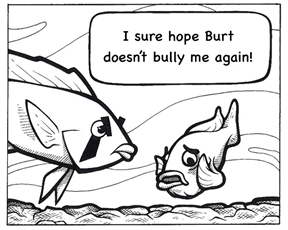Geaux girl fish power!
Hello everyone! I’m Burt’s friend Toni and I want to tell you a little more about us females – Geaux girl fish power! (a bit of Louisiana is creeping into my vocabulary!). While Burt and his other male territorial buddies are really colorful, us ladies are less flashy and we often hang out with the subordinate males (those without a territory). Burt and his macho friends often chase us around, and when the time is right, they also do all kinds of other crazy things in front of us! When our eggs grow large in our ovaries, our bellies get swollen, we have an urge to get rid of them, and we release some chemicals into the water that makes the males do awesome courtship dances. They get really bright colors, quiver their bodies, and make grunt-like sounds in front of us, and then they turn around and wag their tails as they swim towards their territory shelter – they really want us to follow them! When one of us girls agrees to follow him, we go into his territory and lay some of our large yellow yolky eggs on the bottom of the lake (or the tank if we’re in the lab) and then we turn around and pick up the eggs in our mouth! The male then shows off his anal fin and shakes his body on the substrate. Since his anal fin has these big yellowy spots on them that look an awful lot like some of my eggs (see pictures of Burt’s fins in his previous posts), I swim down and start nipping at them. Then he does another crazy thing – he releases some sperm so that they can fertilize the real eggs already sitting in my mouth! Not all fishes reproduce this way, but many of our cichlid relatives in Africa certainly do, and it helps to ensure that our little guys survive.We do all of this because we are mouth brooders, meaning that we hold and care for our developing babies inside our mouths until they grow into little baby fish that can swim on their own. While the babies are growing, there’s lots of pretty amazing things that happen to our bodies!, and my human scientists are studying all sorts of cool things related to this (stay tuned for future posts on these different studies). You might now be wondering “But Toni, how do you eat with all those wriggling baby fish in your mouth?!”. Great question!, and the answer is, we don’t! It takes ~ 2 weeks for the fertilized eggs to develop into little baby fish and we don’t eat during that time so that we can just focus on taking care of the little guys – this is maternal care to the extreme! Once they’re ready to make it on their own, we just open our mouths and let them swim out. But we do keep a sharp eye on them for a few days while they get used to life in the real world by letting them swim back into our mouths whenever something scary happens (like a big predator swims nearby looking for a snack) – this is no easy feat, since there can be up to ~50 babies that need to squeeze in there. After a few days though, they’re on their own!
Well, that’s a brief intro into the fish ladies – check back soon for more detailed stories about how the scientists are studying different aspects of our behavior and physiology!







Comments
Post a Comment